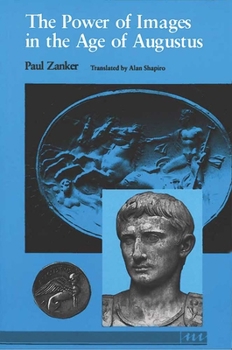The Power of Images in the Age of Augustus
Select Format
Select Condition 
Book Overview
"Art and architecture are mirrors of a society. They reflect the state of its values, especially in times of crisis or transition." Upon this premise Paul Zanker builds an interpretation of Augustan... This description may be from another edition of this product.
Format:Paperback
Language:English
ISBN:0472081241
ISBN13:9780472081240
Release Date:September 1990
Publisher:University of Michigan Press
Length:400 Pages
Weight:1.74 lbs.
Dimensions:0.9" x 6.2" x 9.2"
Customer Reviews
6 ratings
Lives up to the hype!
Published by Carl Allensdottir , 3 years ago
I wondered if this book would really make me see Ancient History in a new light --well, it has! Thought-provoking and elegantly translated, I would recommend it to anyone interested in the subject of late republic and early imperial Roman society.
Perfect!
Published by Thriftbooks.com User , 14 years ago
Book was in perfect shape. I couldn't even tell that it had been used.
Power of Images in the Age of Augustus by Paul Zanker
Published by Thriftbooks.com User , 15 years ago
This is an an extraordinary book and quite relevant to analyzing our own cultural images and how they shape our thinking, beliefs, values, attitudes and most of all our behavior. Zanker shows how a culture can be radically transformed incrementally and over time by its visual images which includes art, architecture, dress, patterns of human interaction, and public entertainment. What's relevant here to our own day is how Rome was transformed from a Republic to the rule of one man and the role of visual images in that process. John F. Gilligan, Ph.D.
Roman Art
Published by Thriftbooks.com User , 22 years ago
This book is an excellent example of how art critique can be used to analyze politics and history. Paul Zanker does an exceptionally thorough job as he systematically works his way through the end of the Republic to the heights of Augustan Rome. The book includes tons of photographs, coins, maps and reproductions to illustrate appropriate points in the text. The thesis of the book is to show how art was used to convey the importance and dignity of the new Imperial system. Despite the breadth of material presented here, the text is smooth and understandable.There really isn't enough space in a review to adequately cover this book. Zanker's main thrust is to show how Augustus rebuilt and remodeled Rome with himself at the center. The styles that Augustus used were quickly picked up and duplicated by the Roman upper classes, as well as those in the provinces. My favorite section of the book concerns the coinage. Augustus minted coins closely linking himself to Julius Caesar in order to establish himself as the heir apparent (which he was) to Caesar. Coins were also used to commemorate Augustus's triumph at Actium over Antony, and also to promote Augustus's conservative legislation concerning marriage and childbirth. Although Augustus slowly consolidated power under the title of princeps, he took great pains to show Rome that he was bringing about peace, prosperity and honor, all things that had been missing during the civil wars. Is Augustan art propaganda? It could certainly be interpreted that way, even though there was no "Ministry of Information" in Rome.An excellent book, although there are a few problems. One of them is the tendency of art critique to see things that others may not. Zanker's descriptions of statues of Augustus are a good example. While I can agree with his depictions of the later Augustan busts as showing a calm, sort of omniscient demeanor, I have a tough time agreeing with his assessment of an earlier bust of Augustus as nervous and power hungry. This is a small problem with an otherwise great book that will make you think about Rome in a different way.
A novel treat: scholarship that's fun to read!
Published by Thriftbooks.com User , 22 years ago
Zanker offers a fascinating reconstruction of Octavian Augustus' agenda for consolidating his position as leader of the Roman world. He does this by careful analysis of the buildings, statues, coins and other physical objects made during the rule of Rome's first emperor. Zanker understands well the impact of visual communication and uses it insightfully. He doesn't simply catalog artifacts, he interprets them and connects them within a broad system of consciously articulated ideology. In two decades of academic reading, this is one of the two most memorable books I read.
Engaging and accessible
Published by Thriftbooks.com User , 25 years ago
A wonderful tour of the early Roman empire framed within a rigorous theoretical discussion. Zanker skillfully illustrates how an empire was built by the manipulation of public thought through the use of images, or in other words, propaganda. Shapiro contributes with a lively and nearly transparent translation.





